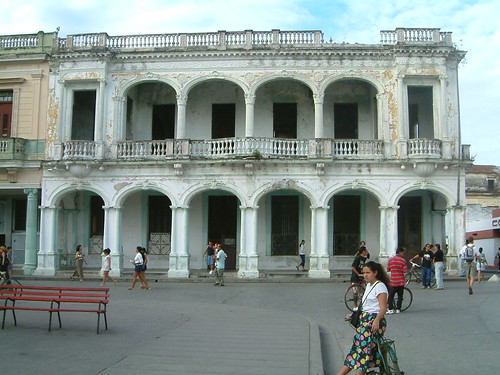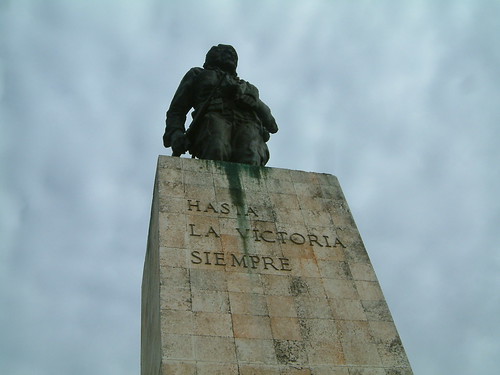The knock was soft, but it woke me up. I pulled the curtains away from the door and peeked my head out, Gracias por la llamada.Thanks for the wake-up call. I started to walk away but the guy started to talk in halting English, Es eight o’clock. I turned to him and ask for the time again just to make sure I heard correctly. Es eight o’clock. Ah, shit, fucking howler monkeys woke me up in the middle of the night; I guess I passed out after that. I am not quite sure of the time difference, but frankly, I haven’t cared much the last two days. All I know is that I missed the tour to Tikal, which left, well, at eight o’clock this morning.
I quickly got ready to talk to front desk and see how I missed the morning tour, but I slowed down when I realized I’ve had three glasses of wine on my porch while typing yesterday’s entry, and another one during dinner. Oh, okay.
I was still groggy from the wake-up call that I turned down breakfast and just chose to have a cup of coffee. Evelyn showed me the tour book to let me pick my activity for the day. I remembered that my stay included free use of their mountain bikes, so I opted for that and went for a ride to Cerro Cahui alone. A very long ride.
It wasn’t even 9am when I left, but I was already drenched in sweat after the second hill. Before I reached the closest village, the road was unpaved and I realized that a stone-covered road gets very taxing after, oh, 15 minutes. I said my holas to cars which didn’t slow down upon spotting me on my bike and to children walking with logs of trees on their shoulders. One of the kids I biked past did the construction-worker whistle. Nice, I thought, start them off early. I spotted an old man with almost no teeth on the side of the road with a machete, clearing the tall brush, and I stopped to ask where the hell Cerro Cahui was. Señor, donde esta entrar para Cerro Cahui? because I’ve seen the bienvenidos sign a few pedals back but not any gates. He rambled an answer in fast Spanish. I nodded as I tried to decipher what he said. All I understood was four kilometers and two doors. Fuck, isn’t four kilometers, like, three more miles? Whatever it was, I knew I had a long way to go. I pedaled on.
I finally arrived at the pearly gates–well, more like rusting metal–and was very thankful. The security guard helped me with my bike up the steps and I paid my 20 quetzales to enter. He showed me the snakes preserved in glass jars which made me look down at my pants and hike my socks up. Great, serpientos in the fucking trail. He showed me the map, explained that there are two trails: one will take an hour and a half, and the other, three hours round-trip, and asked me which one I would do. Yo no se, I said, because after that bike ride, I seriously was not in the mood to walk more than six miles to the lookout points.
So I walked. And I walked. The trail is clearly marked and surrounded by old tree roots. It rained yesterday, so the path was a little damp and slippery. After catching my breath, I felt very calm and relaxed. I had the forest all to myself except for the ubiquitous howler monkeys. Birds, squirrels and a possum-looking orange thing moved around me. I wasn’t alone, but felt like I could scream and no one would hear me. I was short of breath again after a few steep climbs and I stopped at some rock to sit and rest. I only brought a small bottle of water with me and have drank most of it during my bike ride. I realized I could pass out right there and no one would know! My knees were hurting but I kept on.
When I reached the end of the short hike, I debated with myself if I should keep hiking to reach the mirador because I was so tired. I did anyway, thinking in that Cia proud way, I’m here already, so why not? The view of the lake from the lookout was beautiful. The sky was open and I could see soft ripples on the lake from the light breeze. I continued on to the second lookout point, and after I reached that, I just felt there was no reason to stop hiking the long way. (Well, except not having a drop of water to drink but, you know.) I felt a little woozy and I stopped several times before I gathered enough energy to continue.
After what seemed like another hour, I was back where I started. The guard smiled at me and said, Dos horas y media. Muy bien. Two and a half hours, but where’s my reward? There was no drinking water. I spotted a faucet near the toilets, but I didn’t dare drink it without making sure it was purified. If there is one thing worse than being dehydrated, I think it would be sick to my stomach because of unsafe drinking water.
I rested on the steps and watched two guys pay the fee and enter the park. Boys, I hope you have drinking water, I thought, but I realized the car outside was theirs–at least they didn’t have to bike to get there. Their driver saw me looking, stepped out of the car and walked to sit next to me. He introduced himself as Alberto, made small talk and offered to drive me to the nearest restaurant after he heard my stomach growl. I politely told him, Necessito volver en La Lancha to say no, and I said what I needed was water. He motioned for me to come with him, took my empty bottle and filled it with his water from the trunk of his car. Drinking water! I thanked him, short of giving him a hug, and I picked up my bike to go.
What transpired next was a very difficult hour. When I left, the guard told me that it was 15 minutes to one. When I returned to La Lancha with jelly legs, it was two. I fell to a chair, unlaced my boots and steadied my hands. Carlos was serving a family that just arrived, so I had to wait before I got some ice water. He served me cold lime juice because he knew I was tired. Not only did I look it, he told me that he knew I left at 9am and I was out the entire time. I ate my lunch of chile rellenos, roasted peppers stuffed with ground meat, hungrily.
Needless to say, I spent the rest of the afternoon by the pool reading. I took a break only to order coffee upstairs so that I don’t fall asleep. Dinner last night was a civilized salad of lettuce and cucumbers, with fish caught from the lake drizzled with coriander sauce. Tonight, I will order the steak. If I’m going to Tikal tomorrow, I will need all the protein I can get.
Related post/s:
Cerro Cahui, Guatemala photos on Flickr
Me, Myself, and I in La Lancha, Peten, Guatemala



















